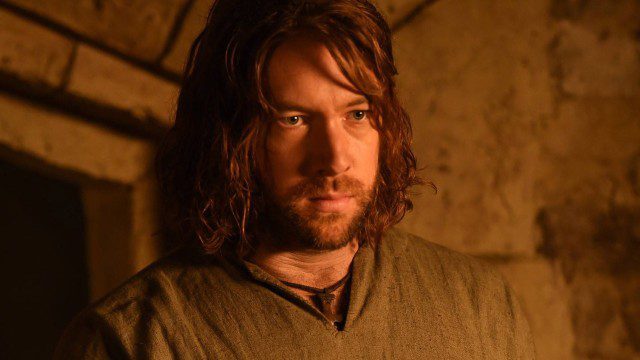(Author’s note: sorry I haven’t been reviewing this lately. Without cable, access to this show has been hard to get, doubly so since FX doesn’t put it on Hulu. But now I have the FX NOW app, so my coverage should be the opposite of my bowel movements: regular. I should go to the doctor.)
In many ways, this was the strongest, most focused episode of The Bastard Executioner to date. The talent behind and in front of the camera is considerable, so the show has never been outright bad, but there have been uneven installments, most of which can be chalked up to the growing pains of any new show. But “Behold the Lamb/Gweled yr Oen” (I’m really liking the Norse subtitles now) was fast-paced, engaging, and most of all, smart. There’s a clear through-line in the episode, looking at the weight that guilt can place on our lives. Kurt Sutter is no stranger to Shakespearean themes, and he wears his heart on his sleeve this time around (it doesn’t hurt that Stephen Moyer is playing Milus as some demented cousin of Othello‘s Iago, which is a hoot to watch).
The suspense inherent in Wilkin’s deceit is that we know that at some point he has to own up to the truth. Bastard flipped that on its head nicely by having Milus find out right away, but by playing up Wilkin’s connection to Love, the truth still remained an important piece of information that one cast member didn’t know. That’s storytelling 101, guys, try to keep up. While I’m not completely buying Wilkin and Love’s relationship yet, the framework has been set up, and I trust the show (and more importantly, Flora Spencer-Longhurst, who kills it every week as Love) not to screw it up.
Wilkin decides that the jig is up when his next victim is brought in: a dreadlocked rebel (lotta white guy dreads on Bastard) who has confessed to the grisly murder of the Baroness of Pryceshire – a murder, you’ll remember, unwittingly carried out by Wilkin and Toran. Wilkin in “don’t give a fuck” mode is way more interesting than Wilkin in, well, pretty much any other mode. There’s a real sense of catharsis as he rips Petra’s crucifix off from around Leon’s neck, and I admire Bastard for getting to this point so quickly, with three episodes left in the season. The battle isn’t exactly consummated, which is a shame, and raises some questions narratively. Like, isn’t it going to be awkward as hell working with Leon now, and won’t Leon wonder why Toran called Wilkin by his real name, and why did Wilkin grab the crucifix first, etc etc? You see the problem this presents.
But I’m okay with a little hiccup like that because it was surrounded by so many good scenes. Lee Jones and Moyer retain the best chemistry on this show, but Jones and Spencer-Longhurst are catching up (okay, she’s FSL now, I’m sick and fuckin tired of typing that name). Wilkin begs her to accept his confession, saying that his soul is heavy, and in themselves they find kindred spirits. I think by coming clean, Wilkin is allowing himself to connect with Love on a deeper, more spiritual and profound level.
Spirituality plays a surprisingly big role on The Bastard Executioner. Well, it’s not too surprising, because this is 15th century Wales, so I should say a surprisingly satisfying role. I’m more and more interested in the conflict between the Rosula and the Seraphim, maybe because Sutter is basically positing them as olde tyme motorcycle gangs in cassocks instead of leathers. The element of mysticism – and the straight-up supernatural, as we saw in “Thorns” – expands this world nicely, and I’m excited to see what Sutter does with it.
A Few Thoughts
- Wilkin actually caring for his new “family” is a nice touch
- This show turned into medieval Sons of Anarchy pretty quickly: did you notice how many people called each other “brother”?
- Another reason I’m looking forward to Rosula vs. Seraphim: more screen time for Timothy V. Murphy, whose Father Ruskin has been tragically underused
- Milus not even bothering to lie about killing Calo is a boss move. Should I start a new feature for these? Boss Move of the Week? Maybe. Seems like something I should have started with episode one
- Was this the first time we’ve seen drawing and quartering on TV? I can’t think of another example. I don’t think even Game of Thrones has shown us that


